Title: Back to the Congo (DRC that is)
Dates: 5th - 7th May GPS:
I was looking forward to our mini two-day excursion to Kinsevere mine site near Lubumbashi, where Ausenco, one of the expedition gold sponsors is building a copper mine for Anvil Mining, another Australian resource company. In particular, I was interested in how the companies develop and work the mine with minimum impact on the environment and how the project benefits the local communities and people of DRC – what sustainable contributions they make to help alleviate poverty.
Simon dropped Zdenek and I off at the Lusaka airport and said our goodbyes. Simon was due to fly back the UK that afternoon having been with us since Yaounde. A small drama unfolded there. When we finally got to check in, they wanted to see our invitation letter from Ausenco, which we did not have. Everything had been arranged in Lubumbashi and we were told that it would all be sorted out on arrival. They refused to let us on the plane until they had clearance that we were going to be able to enter DRC legally. I called my contact Hamish who sorted everything. Just in the nick of time we got the all clear and Zdenek and I sprinted along the tarmac to catch the flight.
Lubumbashi is a city of about six million in the far south east corner of the DRC – just a 45 minute flight north of Lusaka. It lies in what is known as the Copper Belt; a region which produces some of the world’s highest grades of copper. As we stepped off the plane, Joe (Joberty) from Ausenco was there to meet us and everything ran smoothly after that.
Lubumbashi looked to be better kempt than what we’d seen around Kinshasa. The mining industry here drives the economy and we passed some extensive building developments. Kinsevere is about 30km from the city, much of the distance on a private road. Immediately we were made feel very welcome by everyone and after the obligatory safety induction were ready for the grand tour, planned for the next day.
 Ricardo, a construction engineer showed us around the construction site, explaining the process of copper refinement in basic terms, from crushing through to electrowinning (electrolysis). There was quite a bit to see even though Ausenco are not due to finish construction until just before Christmas.
Ricardo, a construction engineer showed us around the construction site, explaining the process of copper refinement in basic terms, from crushing through to electrowinning (electrolysis). There was quite a bit to see even though Ausenco are not due to finish construction until just before Christmas.
I watched and listened with particular interest when we were shown how the acid tanks are made leak-proof with many stringent tests to ensure nothing leaches into the soil during the mine’s 20 year lifespan. ‘Event ponds’ which flank the settling tanks (which will contain a potent cocktail) are designed to hold and contain the fluids should the system malfunction.
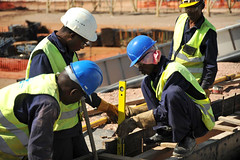 The site CEO, Bill Webb then kindly gave us some of his time to discuss the project and give an overall perspective of how he manages such complicated logistics, employees from 12 different countries (I think 12), liaises with the local community and the authorities – and how they produce a state-of-the-art mine for their client, Anvil. They employ a substantial number of (mostly) unskilled local workers, therefore providing employment for people in surrounding villages.
The site CEO, Bill Webb then kindly gave us some of his time to discuss the project and give an overall perspective of how he manages such complicated logistics, employees from 12 different countries (I think 12), liaises with the local community and the authorities – and how they produce a state-of-the-art mine for their client, Anvil. They employ a substantial number of (mostly) unskilled local workers, therefore providing employment for people in surrounding villages.
As Ausenco are only there for the length of the contract which is about two years, they have to be careful that the work they do for the surrounding communities is sustainable while avoiding the trap of just giving handouts. Bill said they are organising a contribution of some educational equipment and books to local schools before they complete their job in December. Anvil, on the other hand, will be in the region at least for the lifespan of the mine, so they have taken the opportunity to put in place some excellent initiatives.
Phil (Ausenco) introduced Zdenek and me to Michel Santos, is Anvil’s Community Development Officer. Michel explained Anvil’s commitment to improving social infrastructure and the extensive community program. One of the most important programs, I think, involves facilitating village leadership; mobilising a range of community leaders, such as the headman, teachers, women… and teaching organisational skills, decision making, planning and management skills. With a better social structure these communities will be able to take charge of their direction and cope with challenges as they arise. They have provided 15 villages with 26 boreholes and built schools.
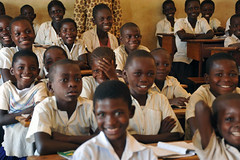 We drove just outside the mine grounds to Kinsevere Primary School and dropped in on one of the classes. Not only have they built the school and provided learning equipment, they have also paid the teachers’ salaries as the government had failed to do so. These children are now at least having the option of a primary education. Anvil has also been looking after the women by setting up literacy classes for adult women. This includes providing training in forward planning and money management.
We drove just outside the mine grounds to Kinsevere Primary School and dropped in on one of the classes. Not only have they built the school and provided learning equipment, they have also paid the teachers’ salaries as the government had failed to do so. These children are now at least having the option of a primary education. Anvil has also been looking after the women by setting up literacy classes for adult women. This includes providing training in forward planning and money management.
Beside the school is a new health centre, soon to be equipped. With both education and health they are working with other stakeholders, including local NGOs to ensure that when they leave, the work with appropriate expertise is continued.
Another vital area where Anvil is making a difference is with food security and agronomy. 440 farmers have been provided maize and vegetable seeds as a loan; the seeds are paid back after harvest. The farmers are educated about how to plant, when, how much fertiliser to use and the importance of weeding to maximise production. This program also teaches business skills and the importance of saving for tougher times.
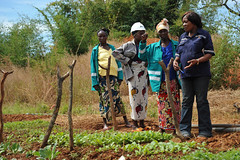 On the final morning, before Zdenek and I returned to Lusaka, we made a small tour of the region with Elise (Community Development) and Dedy (Agronomist). We visited a vegetable garden at Kinsevere which makes use of purified water from the mine. Nine women and one man worked the garden. Dedy was responsible for teaching them how to grow a range of vegetables which they wouldn’t normally have grown. They are able to sell the vegetables to the mine and provide for their communities.
On the final morning, before Zdenek and I returned to Lusaka, we made a small tour of the region with Elise (Community Development) and Dedy (Agronomist). We visited a vegetable garden at Kinsevere which makes use of purified water from the mine. Nine women and one man worked the garden. Dedy was responsible for teaching them how to grow a range of vegetables which they wouldn’t normally have grown. They are able to sell the vegetables to the mine and provide for their communities.
We drove to Mumanga, a village about 25km from the mine. Here it seemed they were expecting Anvil to provide everything for them – unfortunately it appeared like a bit of a ‘hand out scenario’. They wanted a new building to house the TV they were given as the rains had destroyed their last one. I thought this was not priority and something the village should be able to take care of. So when I asked the headman what he thought his village needed most, I was pleased to hear him say that they most needed better school and learning facilities.
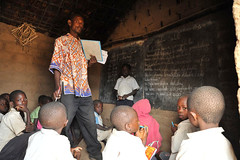 The school houses were three tiny traditional mud and thatch buildings spread amongst other village buildings – quite a contrast to the new school at Kinsevere. The forty-two students of the second form primary class were crammed into a tiny space (see photos). The pump seemed to be in constant use while we were there.
The school houses were three tiny traditional mud and thatch buildings spread amongst other village buildings – quite a contrast to the new school at Kinsevere. The forty-two students of the second form primary class were crammed into a tiny space (see photos). The pump seemed to be in constant use while we were there.
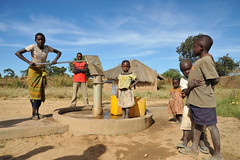 One lady insisted we inspect her ‘show house’; consisting of a living room and two bedrooms. Her four children shared a single bed which was far too small for just me! She then insisted we try some of their homebrew liquor. It was rocket fuel – very rough and even worse at 9.30 in the morning.
One lady insisted we inspect her ‘show house’; consisting of a living room and two bedrooms. Her four children shared a single bed which was far too small for just me! She then insisted we try some of their homebrew liquor. It was rocket fuel – very rough and even worse at 9.30 in the morning.
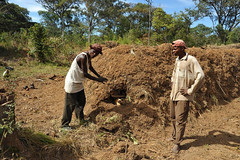 Returning from Mumanga we stopped to talk to some charcoal producers. The forest is slowly being erased because of the growing population’s need for fuel. The charcoal burners we spoke to said they had been given one hectare of bush to clear. Trees were cut and the wood arranged inside an earth furnace. They said they could produce 25 large bags of charcoal which they carried by bicycle to Lubumbashi to sell.
Returning from Mumanga we stopped to talk to some charcoal producers. The forest is slowly being erased because of the growing population’s need for fuel. The charcoal burners we spoke to said they had been given one hectare of bush to clear. Trees were cut and the wood arranged inside an earth furnace. They said they could produce 25 large bags of charcoal which they carried by bicycle to Lubumbashi to sell.
Once the land was cleared it was to be turned into a maize field. This process is eating up forests throughout the DRC, Zambia and east Africa. (In West Africa it was mainly firewood being cut rather than charcoal burning, but the result is the same) As I returned on the flight to Lusaka I had a thought – What if these people could be educated about the virtues of Farmer Managed Natural Regeneration? (FMNR is the technique which was featured in Niger which is reversing the desertification process by using a simple pruning technique – see Hippopotamus for Christmas blog).
Zdenek and I really enjoyed our two day excursion to the Kinsevere mine site and thank Ausenco for supporting the tour. The visit has given another insight into how foreign companies can have a positive impact in the region they are working – a two-way relationship.
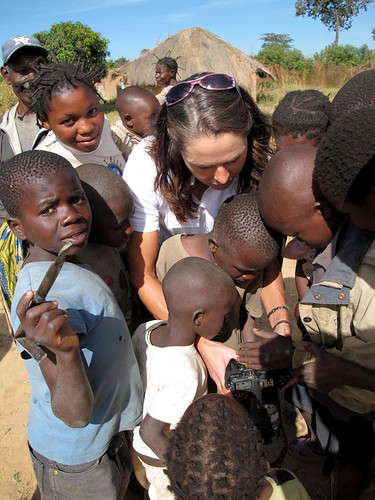

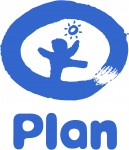

{ 2 comments… read them below or add one }
This equally great Kate and I m sending you heaty greetings from Cameroon.
We celebrated 50YEARS of Independence last Thursday, May 20,National Day.
Dear Kate
I have just been reading your diary and i am very impressed. I am the CSR Officer for African Milling here in Lubumbashi and am trying to look for parners in our school building project for 2011 at our farm. I would appreciate any suggestions especially for donations in books and learning materials. We have the construction covered and we are expecting to have completed the project by the end of this year. This is my first time visiting your site and i really appreciate what you have to say.
thank and regards
Yona